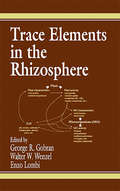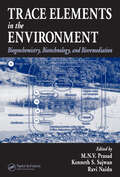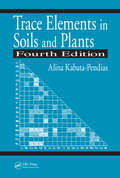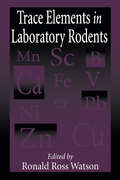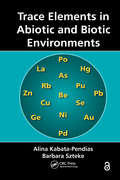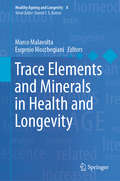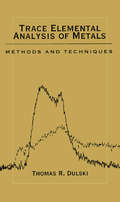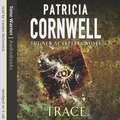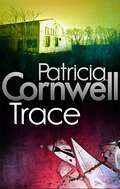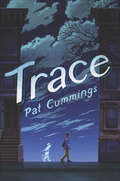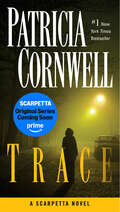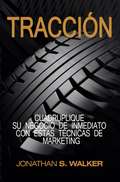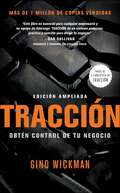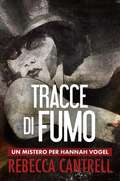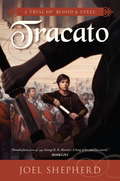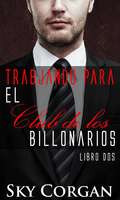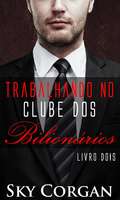- Table View
- List View
Trace Elements: A Comissario Guido Brunetti Mystery (A Commissario Guido Brunetti Mystery #30)
by Donna LeonThe New York Times–bestselling author of Unto Us a Son Is Given continues &“one of the most exquisite and subtle detective series ever&” (The Washington Post). When a dying hospice patient gasps that her husband was murdered over &“bad money,&” Commissario Brunetti softly promises he and his colleague, Claudia Griffoni, will look into what initially appears to be a private family tragedy. They discover that the man had worked in the field, collecting samples of contamination for a company that measures the cleanliness of Venice&’s water supply, and that he had recently died in a mysterious motorcycle accident. Piecing together the tangled threads, Brunetti comes to realize the perilous meaning in the woman&’s accusation and the threat it reveals to the health of the entire region. But justice in this case proves to be ambiguous, as Brunetti is reminded it can be when he reads Aeschylus&’s classic play The Eumenides. Praise for Donna Leon&’s Commissario Brunetti Mysteries &“[Leon] has never become perfunctory, never failed to give us vivid portraits of people and of Venice, never lost her fine, disillusioned indignation.&” —Ursula K. LeGuin, author of Dancing at the Edge of the World &“You become so wrapped up in these compelling characters. . . . Each one is better than the last.&” —Louise Erdrich, winner of the National Book Award for Fiction &“Leon&’s Venetian mysteries never disappoint, calling up the romantic sights and sounds of La Serenissima even as they acquaint us with the practical matters that concern the city&’s residents.&” —The New York Times Book Review &“The sophisticated but still moral Brunetti, with his love of food and his loving family, proves a worthy custodian of timeless values and verities.&” —The Wall Street Journal
Trace Elements in the Rhizosphere
by George R. Gobran Walter W. Wenzel Enzo LombiThe first book devoted to the complex interactions between trace elements, soils, plants, and microorganisms in the rhizosphere, Trace Elements in the Rhizosphere brings together the experimental, investigative, and modeling branches of rhizosphere research. Written by an international team of authors, it provides a comprehensive overview of the me
Trace Elements in the Environment: Biogeochemistry, Biotechnology, and Bioremediation
by M.N.V. Prasad Ravi Naidu Kenneth S. SajwanNew analytical techniques have enhanced current understanding of the behavior of trace and ultratrace elements in the biogeochemical cycling, chemical speciation, bioavailability, bioaccumulation, and as applied to the phytoremediation of contaminated soils. Addressing worldwide regulatory, scientific, and environmental issues, Trace Elements in th
Trace Elements in Waterlogged Soils and Sediments (Advances in Trace Elements in the Environment #3)
by Michael Paller Anna Sophia KnoxMany wetlands around the world act as sinks for pollutants, in particular for trace elements. In comparison to terrestrial environments, wetlands are still far less studied. A collaborative effort among world experts, this book brings the current knowledge concerning trace elements in temporary waterlogged soils and sediments together. It discusses factors controlling the dynamics and release kinetics of trace elements and their underlying biogeochemical processes. It also discusses current technologies for remediating sites contaminated with trace metals, and the role of bioavailability in risk assessment and regulatory decision making. This book is intended for professionals around the world in disciplines related to contaminant bioavailability in aquatic organisms, contaminant fate and transport, remediation technologies, and risk assessment of aquatic and wetland ecosystems.
Trace Elements in Soils and Plants
by Alina Kabata-PendiasStill the Gold Standard Resource on Trace Elements and Metals in SoilsThis highly anticipated fourth edition of the bestselling Trace Elements in Soils and Plants reflects the explosion of research during the past decade regarding the presence and actions of trace elements in the soil-plant environment. The book provides information on the biogeoch
Trace Elements in Soil: Bioavailability, Flux, and Transfer
by M. B. Kirkham I. K. IskandarHistorically, research on the methods and amounts of trace element application to agriculture soils for correcting plant deficiencies has received major attention. More recently, due to industrial development and past disposal activities, trace elements are considered to be important environmental contaminants that affect all components in the atmo
Trace Elements in Laboratory Rodents (Methods In Nutritional Research Ser.)
by Ronald Ross WatsonWritten by the international community's leading experts, Trace Elements in Laboratory Rodents describes the best and most current methods to provide deficient or supplemental trace elements to laboratory animals, as well as how to assay them. The experts warn of the common pitfalls and hidden problems in nutritional testing and how to avoid them. This how-to approach focuses on the technical details that make good, reliable studies. Common as well as rare or recently recognized minerals are described relating to both dietary supplementation and measurement in tissues.If you are a researcher, professor, or student working in nutrition, food science, biochemistry, or veterinary medicine, you can't afford to be without this excellent hands-on methods manual!
Trace Elements in Coal and Coal Combustion Residues (Advances In Trace Substances Research Ser. #5)
by Robert F. Keefer Kenneth S. SajwanTrace Elements in Coal and Coal Combustion Residues focuses on trace metal chemistry of coal and coal combustion residues. Special emphasis is placed on management of coal combustion residues in electric power plants and the influence of coal and associated residues on soils, plants, water, and animals. Topics covered include a brief summary of research sponsored by Electric Power Research Institute, environmental pollution from coal combustion plants in low-rainfall regions, accumulation of trace elements in freshwater mussels near a power plant, testing to evaluate fossil fuel wastes by chemicals and isotopes, transport of metals from coal piles and ash impoundments, leachability and toxicity of metals in fly ash, and plant absorption of chemicals from ash. The book will be a useful reference for environmental and reclamation consultants, environmental engineers, toxicologists, environmental regulatory personnel, officials with electric power utilities and water treatment plants, and soil scientists.
Trace Elements in Brain Health and Diseases (Nutritional Neurosciences)
by Wael Mohamed Rajat SandhirThis book reviews the role of trace elements in brain development, function, metabolism, and neurodegenerative disorders. It explores the molecular mechanisms of the effects of trace elements on metabolic pathways, mitochondrial nutrients, neurodegeneration, Central Nervous System (CNS) disorders, cell signaling, and neuronal functions. The book also discusses transport mechanisms of trace elements within CNS and their impact on neurotransmitter biology. Further, it examines the deleterious effects due to dyshomeostasis of trace elements in the central nervous system (CNS), resulting in damage to neurons and glial cells through the generation of reactive oxygen species and oxidative stress turn leading to neurodegeneration and neurological dysfunction. The book also explores the putative role of trace element deficiency in psychiatric disorders, including depression, and the imbalance of trace elements on neuronal genomic stability.
Trace Elements in Abiotic and Biotic Environments
by Alina Kabata-Pendias Barbara SztekeThis book helps readers understand the fundamental principles and phenomena that control the transfer of trace elements. It describes the occurrence and behavior of trace elements in rocks, soil, water, air, and plants, and also discusses the anthropogenic impact to the environment. In addition, the book covers the presence of trace elements in feeds, as either contaminants or as nutritional or zootechnical additives, and their transfer across the food chain to humans. All trace elements are covered-from aluminum to zirconium-as well as rare-earth elements (actinides and lanthanides).
Trace Elements and Minerals in Health and Longevity (Healthy Ageing and Longevity #8)
by Marco Malavolta Eugenio MocchegianiThis book describes the role of trace elements in health and longevity, pursuing a biogerontological approach. It offers essential information on the impact of trace elements on molecular and physiological processes of aging, and on their impact on health in connection with aging. The major topics covered in its 11 chapters, each dedicated to a specific trace element or mineral, are: a) Role of the element in species longevity, b) Recommended intake for longevity in animal species and in the elderly, c) Deficiency and age-related disease, d) Excess/toxicity and age-related disease, ande) Interactions with drugs prescribed in the elderly. Clinical, animal and other laboratory models of interest in aging are included, which enable a more in-depth analysis to be made. The respective chapters are a mixture of overviews and more in-depth reviews in which the mechanisms of aging are described from the point of view of their specific interactions with trace elements and minerals.
Trace Elemental Analysis of Metals: Methods and Techniques
by Thomas R. DulskiThis work details minor, trace and ultratrace methods; addresses the essential stages that precede measurement; and highlights the measurement systems most likey to be used by the pragmatic analyst. It features key material on inclusion and phase isolation. The book is designed to provide useful maps and signposts for metals analysts who must verify that stringent trace level compositional specifications have been met.
Trace Analysis with Nanomaterials
by Julia Xiaojun Zhao David T. PiercePresenting a wide variety of methods, this book provides a comprehensive overview of the current state -- ranging from bioanalysis to electrochemical sensing, forensics and chemistry, while also covering the toxicity aspects of nanomaterials to humans and the environment. Edited by rising stars in the field, the first section on biological analysis includes an investigation of nanoparticles and micro- and nanofluidic systems, while the second, environmental analysis, looks at the detection, monitoring, and sensing of explosives as well as pollutants, among other topics. The final part covers such advanced methods as the synthesis and characterization of gold nanorods. For analytical chemists, materials scientists, chemists working in trace analysis, and spectroscopists.
Trace Analysis with Microcolumn Liquid Chromatography
by Milos KrejciThis book provides a detailed description of technical elements of a microbore column liquid chromatograph suitable for use in trace analysis. It presents examples of analyses, especially from the spheres of biochemistry, pharmacology, and environmental analytical chemistry.
Trace Analysis of Specialty and Electronic Gases
by Mark W. Raynor William M. GeigerExplores the latest advances and applications of specialty and electronic gas analysis The semiconductor industry depends upon a broad range of instrumental techniques in order to detect and analyze impurities that may be present in specialty and electronic gases, including permanent gases, water vapor, reaction by-products, and metal species. Trace Analysis of Specialty and Electronic Gases draws together all the latest advances in analytical chemistry, providing researchers with both the theory and the operating principles of the full spectrum of instrumental techniques available for specialty and electronic gas analysis. Moreover, the book details the advantages and disadvantages of each technique, steering readers away from common pitfalls. Featuring contributions from leading analytical and industrial chemists, Trace Analysis of Specialty and Electronic Gases covers a wide range of practical industrial applications. The book begins with the historical development of gas analysis and then focuses on particular subjects or techniques such as: Metals sampling and ICP-MS analysis Improvements in FTIR spectroscopy Water vapor analysis techniques New infrared laser absorption spectroscopy approaches GC/MS, GC/AED, and GC-ICP-MS techniques Gas chromatography columns Atmospheric pressure ionization mass spectrometry Lastly, the book examines gas mixtures and standards that are critical for instrument calibration. There are also two appendices offering information on fittings and material compatibility. With its thorough review of the literature and step-by-step guidance, Trace Analysis of Specialty and Electronic Gases enables researchers to take full advantage of the latest advances in gas analysis. Although the book's focus is the semiconductor and electronics industry, analytical chemists in other industries facing challenges with such issues as detection selectivity and sensitivity, matrix gas interference, and materials compatibility will also discover plenty of useful analytical approaches and techniques.
Trace (Kay Scarpetta)
by Patricia CornwellThe thirteenth book in the Kay Scarpetta series, from No. 1 bestselling author Patricia Cornwell. 'America's most chilling writer of crime fiction' The TimesAgainst her own judgement and the advice of Benton Wesley and her niece, Lucy, Scarpetta agrees to return to Virginia as a consultant pathologist on a case involving the death of a fourteen-year-old girl. Accompanied by Pete Marino she finds the once familiar territory of her morgue and her department much changed, and the new Chief Medical Examiner treats her with disdain despite the obvious fact that he is in desperate need of her expertise. But professional as ever, she re-examines the evidence and proves the girl was murdered. She also finds trace evidence which matches that found on an accident victim and at the scene where one of Lucy's operatives was attacked. It is not only a forensic puzzle, but opens up the probability that someone is after those closest to Scarpetta. Praise for the groundbreaking series: 'One of the best crime writers writing today' Guardian 'Devilishly clever' Sunday Times 'The top gun in this field' Daily Telegraph 'Forget the pretenders. Cornwell reigns' Mirror 'The Agatha Christie of the DNA age' Express
Trace (Kay Scarpetta #13)
by Patricia CornwellThe thirteenth book in the Kay Scarpetta series, from No. 1 bestselling author Patricia Cornwell. 'America's most chilling writer of crime fiction' The TimesAgainst her own judgement and the advice of Benton Wesley and her niece, Lucy, Scarpetta agrees to return to Virginia as a consultant pathologist on a case involving the death of a fourteen-year-old girl. Accompanied by Pete Marino she finds the once familiar territory of her morgue and her department much changed, and the new Chief Medical Examiner treats her with disdain despite the obvious fact that he is in desperate need of her expertise. But professional as ever, she re-examines the evidence and proves the girl was murdered. She also finds trace evidence which matches that found on an accident victim and at the scene where one of Lucy's operatives was attacked. It is not only a forensic puzzle, but opens up the probability that someone is after those closest to Scarpetta. Praise for the groundbreaking series: 'One of the best crime writers writing today' Guardian 'Devilishly clever' Sunday Times 'The top gun in this field' Daily Telegraph 'Forget the pretenders. Cornwell reigns' Mirror 'The Agatha Christie of the DNA age' Express
Trace
by Pat CummingsIn a debut novel that's perfect for fans of Jason Reynolds and Erin Entrada Kelly, award-winning author/illustrator and educator Pat Cummings tells a poignant story about grief, love, and the untold stories that echo across time. Trace Carter doesn’t know how to feel at ease in his new life in New York. Even though his artsy Auntie Lea is cool, her brownstone still isn’t his home. Haunted by flashbacks of the accident that killed his parents, the best he can do is try to distract himself from memories of the past.But the past isn’t done with him. When Trace takes a wrong turn in the New York Public Library, he finds someone else lost in the stacks with him: a crying little boy, wearing old, tattered clothes.And though at first he can’t quite believe he’s seen a ghost, Trace soon discovers that the boy he saw has ties to Trace’s own history—and that he himself may be the key to setting the dead to rest.
Trace
by Patricia CornwellWITH A NEW INTRODUCTION BY THE AUTHOR Dr. Kay Scarpetta, now freelancing from south Florida, returns to the city that turned its back on her five years ago. Richmond, Virginia's recently appointed chief medical examiner claims that he needs Scarpetta's help to solve a perplexing crime. When she arrives, however, Scarpetta finds that nothing is as she expected: her former lab is in the final stages of demolition; the inept chief isn't the one who requested her after all; her old assistant chief has developed personal problems that he won't reveal; and a glamorous FBI agent, whom Scarpetta dislikes instantly, meddles with the case. Deprived of assistance from colleagues Benton and Lucy, who are embroiled in what first appears to be an unrelated attempted rape by a stalker, Scarpetta is faced with investigating the death of a fourteen-year-old girl, working with the smallest pieces of evidence--traces that only the most thorough hunters can identify. She must follow the twisting leads and track the strange details in order to make the dead speak--and to reveal the sad truth that may be more than even she can bear...
Tracción: Cuadruplica las ganancias de tu negocio inmediatamente con estas técnicas de mercadeo
by Jonathan S. WalkerConsigue que tu negocio alce el vuelo como nunca antes con estas estrategias vitales. ¿Careces de un método comprobado para ganar tracción en tu nuevo negocio? ¿Necesitas una manera de atraer posibles inversores para obtener ventaja sobre tus competidores? ¿Quieres ganar un impulso creciente para tu negocio que guíe rápidamente a tu compañía hacia el logro de metas y objetivos concretos? ¿Qué harías si te dijera que hay una forma de obtener todo eso, de prevenir que tu compañía sufra desde su punto de partida, y que en vez de eso, se convierta en una máquina de generar ganancias? ¿Esa información tendría algún valor para ti? Te presento el libro Tracción: ¡Cuadruplica las ganancias de tu negocio inmediatamente con estas técnicas de mercadeo! Las estrategias comprobadas para hacer que tu negocio cumpla con todas las metas que le pongas. Aquí tienes un delante de las cosas sobre las que aprenderás en este libro para obtener un gran punto de partida para tu negocio: - El poder de las tarjetas de presentación. - El uso estratégico de las Redes Sociales. - Invertir en Mercadeo por Correo Electrónico (Top de estrategias para campañas de mercadeo). - Estrategias de Mercadeo Viral. - Incrementar la escala de tus campañas publicitarias, desde lo pequeño a lo más grande. Y mucho, mucho más. - - - ¡Bono! - - - Por un tiempo limitado, también recibirás el siguiente contenido incluido en este libro: - La importancia del Mercadeo Fuera de Internet. - Estrategias de Mercadeo por Afiliación. - ¿Por qué necesitas asistir a compromisos para hablar en público? Consigue tu copia de este libro ¡HOY! No pierdas la oportunidad de adquirir el sorprendente conocimiento registrado en este libro de estrategias para negocios. ¡El precio también podría subir, así que ve ya mismo a la parte superior de esta página y presiona
Traccion: Obtén Control de Tu Negocio
by Gino Wickman¿TIENES EL CONTROL DE TU NEGOCIO O TU NEGOCIO TE CONTROLA A TI? La mayoría de emprendedores y líderes de negocios enfrentan frustraciones similares - conflictos entre el personal, problemas con las ganancias, y crecimiento inadecuado. Pareciera que nunca se toman decisiones, o, al tomarse, no se implementan correctamente. Pero hay una solución. No es complicado ni teórico. El Sistema Operativo Empresarial o Entrepreneurial Operating System® (EOS), es un método práctico para obtener el éxito empresarial que siempre has deseado. Más de 80,000 empresas han descubierto lo que EOS puede hacer. En TRACCIÓN, aprenderás los secretos para fortalecer los seis componentes clave de tu negocio. Descubrirás una forma sencilla pero poderosa para dirigir tu empresa que dará a ti y a tu equipo administrativo mayor enfoque, mayor crecimiento, y mayor disfrute. Empresas exitosas están aplicando TRACCIÓN cada día para dirigir negocios rentables y sin frustraciones- y puedes hacer lo mismo.
Tracce Di Fumo
by Rebecca Cantrell Elena D'AmbrosioBerlino, 1931La Germania sta per cadere nelle mani dei nazisti. Truppe d'assalto e comunisti si scontrano nelle strade. Gli ebrei più ricchi e gli intellettuali pensano solo a come fuggire. I club di Berlino sono pieni di emarginati sociali e di persone dai più svariati orientamenti sessuali, pronti a raccogliere un ultimo ballo.Hannah Vogel vive sola e lavora come reporter di cronaca nera.Durante un'indagine di routine, trova la foto di suo fratello nella Hall dei Morti Senza Nome. Ma ha prestato i suoi documenti ad alcuni amici ebrei in fuga, e non può identificarne il corpo e fare avviare le indagini.Sarà lei stessa a mettersi sulle tracce dell'assassino.Recensioni:«Narrazione intensa in un'agghiacciante ambientazione storica... un contesto insolitamente vivido da cui Hannah racconta la decadenza del suo mondo, cercando di non perdere la vita, o la testa.» The New York Times Book Review«Un ritratto crudo e realistico della Berlino degli anni '30. Mantenendo sempre alta la suspense, la Cantrell riesce con un ottimo lavoro a descrivere le paure dell'epoca attraverso i suoi personaggi. Decisamente raccomandato.» Library Journal«Un romanzo d'esordio inquietante. Evocativo, compassionevole, e coinvolgente.» Kirkus Reviews«La Cantrell riesce a descrivere sia l'atmosfera gioiosa del cabaret, sia la disperazione che galleggia tra le bollicine di champagne. Un debutto promettente.» Booklist«Ambientato nella Berlino del 1931, il romanzo di debutto della Cantrell, scrupolosamente documentato, tributa un oscuro requiem alla Germania di Weimar nei suoi ultimi giorni. Questo romanzo indimenticabile, doloroso da leggere quanto la storia che fa presagire, si conclude con un finale giustamente agrodolce.» Publishers Weekly«Una storia umana e avvincente che cattura brillantemente l'atmosfera che si respirava a Berlino durante l'ascesa del nazismo.» Anne Perry, aut
Tracato (Trial of Blood and Steel #3)
by Joel ShepherdFor two hundred years Tracato has been the center of enlightenment, as the serrin have occupied human lands and sought to remake humanity anew. But the serrin have not destroyed Rhodaan's feudal families entirely, and as Tracato faces the greatest threat to its survival in two centuries, old rivalries are stirring. Sasha must assist her mentor Kessligh to strengthen the Tracato Nasi-Keth, yet with one royal sister siding with the feudalists and another soon to be married to Tracato's most powerful foe, her loyalties are agonizingly divided. Worse still, from Sasha's homeland the Army of Lenayin are marching to make war upon Tracato. Can she fight her own people? Or must she join them, and fight not only her lover Errollyn, but to extinguish the brightest light of hope in all the land--serrin civilization itself?
Trabjando para el Club de los Billonarios: Libro dos
by Adriana Rojas Sky CorganEl mundo de Raven Tarley se car cuando llega a la casa de playa de Croix y lo encuentra abrazando a otra mujer. Los secretos son revelados que cambiaran su relación por siempre. SI no fuera poco, su pasado regresa a asomar su desagradable cabeza. Derrick no es la única persona que la ha seguido de California. Todo está cambiando tan rápido que Raven apenas puede mantenerse al tanto. Parece como si su vida se estuviera derrumbando frente a sus ojos. ¿Podrá ella manejarlo todo en el final? y ¿Croix se mantendrá a su lado cuando las cosas lleguen al punto más bajo?
Trabalhando no Clube dos Bilionários - Livro Dois
by Sky Corgan Nelson Leonel De BenedettiDe Sky Corgan vem a sequência do Trabalhando no Clube dos Bilionários, uma série de duas partes. O mundo de Raven Tarley desmoronou quando ela entrou na casa de praia de Croix e o encontrou abraçando outra mulher. Segredos são revelados que vão mudar seu relacionamento para sempre. Como se isso não fosse suficiente, o passado dela volta a levantar a feia cabeça. Derrick não é a única pessoa que a seguiu da Califórnia. Tudo está mudando tão rapidamente que Raven mal consegue acompanhar. Parece que toda a sua vida está desmoronando diante de seus olhos. Ela será capaz de colocar tudo junto no final? E Croix ficará ao lado dela quando as coisas atingirem o mais baixo dos mínimos?

